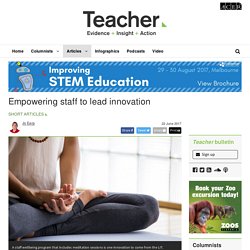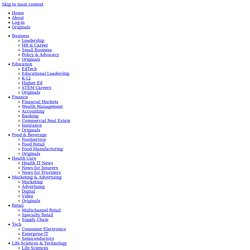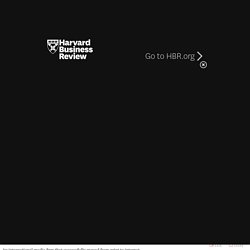

Instructional leadership: Refining the model. Google Spent Years Studying Effective Teams. This Single Quality Contributed Most to Their Success. The best companies are made up of great teams.

You see, even a company full of A-players won't succeed if those individuals don't have the ability to work well together. That's why not too long ago, Google set out on a quest to figure out what makes a team successful. They code-named the study Project Aristotle, a tribute to the philosopher's famous quote "The whole is greater than the sum of its parts. " To define "effectiveness," the team decided on assessment criteria that measured both qualitative and quantitative data. They analyzed dozens of teams and interviewed hundreds of executives, team leads and team members.
The researchers then evaluated team effectiveness in four different ways: 1. executive evaluation of the team; Edutopia. Leadership Q&A with Viviane Robinson - Teacher. In today’s leadership Q&A, Teacher talks to New Zealand academic Viviane Robinson about the challenges and complexities of school leadership, good goal setting and principal professional development.

Robinson is a Distinguished Professor in the Faculty of Education at the University of Auckland, and Academic Director of its Centre for Educational Leadership. And later this month, she’ll deliver the opening keynote at ACER’s Research Conference 2017. You've worked in many countries (Chile, Singapore, England and Denmark, to name a few). What are the common school leadership challenges? In terms of educational policies, governments are choosing to focus on very similar things. School leadership – taking a hands-on role - Teacher. As a principal, do you roll up your sleeves and get involved alongside your teachers when implementing school improvement programs?

Research shows school leaders who take a hands-on approach develop strong collaborative support. ‘When school leaders have a hands-on leadership role, especially regarding literacy and numeracy programs, they build coherence and shared commitment to those programs as well as expanding teachers’ professional learning,’ Dr Scott Paris tells Research Developments (RD). The Director of Policy Research and Practice at the Australian Council for Educational Research (ACER) adds they also increase program effectiveness by building trust among staff.
Paris, an international expert on literacy, says: ‘In my experiences working with school improvement teams, every effective innovation had a deeply engaged principal who worked alongside teachers to understand and implement new techniques for teaching and learning.’ Empowering staff to lead innovation - Teacher. School improvement is very much a collaborative effort.

At the Southern Cross School of Distance Education (SCSODE) in New South Wales, staff are invited to pursue their own ideas around teaching and learning projects through a Learning Innovation Team (LIT). The team was established in 2016 after deputy principal Sharon Hodgson attended an Education Changemakers training course offered through the state education department’s Futures Learning Unit. Research to practice – implementation in education - Teacher. High quality implementation of educational approaches can have a significant impact on improving students’ outcomes.

Implementation is generally defined as a specified set of planned and intentional activities designed to integrate evidence-based practices into real-world settings (Mitchell, 2011). Approaches, practices and interventions delivered in real-world school and classroom settings often look different from what was originally intended. Principals and teachers may decide to adapt elements of a program, and barriers in the school system may prevent an approach from being fully realised.
What this shows is the importance of the quality of the implementation in affecting learning gains, rather than the program itself. Implementation strategies such as training and ongoing teacher support are important to consider in efforts to encourage positive student outcomes. The application of implementation science in education is slowly emerging (Albers & Pattuwage, 2017).
Infographic: School teaching as a highly regarded profession - Teacher. Skip to main content Infographic: School teaching as a highly regarded profession Infographics.

Teachers Quit Principals, Not Schools — Indy / Ed. Randall did not quit because he didn’t love his job.

The Tough Work of Improving School Culture. My school, Bagnall Elementary School in Groveland, Massachusetts, has moved away from principal-driven (top-down) initiatives, and has worked to strengthen teacher collaboration, through which teachers have both increased autonomy and responsibility for achieving intended outcomes.

Like many schools that have made this shift, we have experienced growing pains and unexpected bumps in the road. Collaboration Complications. The power of leadership vulnerability. When you think of the most effective leaders you’ve worked with, how would you describe them?

Perhaps you said “charismatic,” “energetic” or “visionary.” One word that probably didn’t spring immediately to your lips? "Vulnerable. " That's too bad, because vulnerability is a powerful ally that helps leaders gain the cooperation necessary to get things done at work. One of the best bosses I ever had was a soft-spoken, thoughtful person who excelled at building relationships with his direct reports.
To Seize the Future, Create a Leadership Circle. A global pharmaceutical company was about to lose the strategic advantage of several blockbuster drugs coming off patent.

In five years, the revenue shortfall would be significant. The senior commercial and scientific directors formed a “circle of leaders” comprised of 23 senior managers who had no meaningful history of collaboration on strategic initiatives. The hope was that the diversity of brainpower and perspectives would yield imaginative ways to outgrow the shortfall. A Step-by-Step Guide to Structuring Better Meetings. From The New York Public Library I am frequently flummoxed by the complete misalignment between a team’s mandate and the agenda for their meetings. My favorite example was a Corporate Affairs team that had an ambitious agenda to work collaboratively to transform the perception of the organization among members of the public, the regulator, and three levels of government.
Yet they had only allocated 30 minutes per week to the task! They aren’t the only ones. Inevitably, teams fail to link the structure (i.e., content, frequency, and duration) of their meetings with the job that needs to be accomplished in those meetings. There are a few simple steps that will help you build a better meeting structure. Embracing Agile. Agile innovation methods have revolutionized information technology. Over the past 25 to 30 years they have greatly increased success rates in software development, improved quality and speed to market, and boosted the motivation and productivity of IT teams.
Now agile methodologies—which involve new values, principles, practices, and benefits and are a radical alternative to command-and-control-style management—are spreading across a broad range of industries and functions and even into the C-suite. National Public Radio employs agile methods to create new programming. John Deere uses them to develop new machines, and Saab to produce new fighter jets. Intronis, a leader in cloud backup services, uses them in marketing. The spread of agile raises intriguing possibilities. Great Leaders Embrace Office Politics. A rising young executive found herself strategically ousted in an internal power play. Jill had all the chops to rise to the corner office: consistent top 10% performer, hardworking, intelligent, personable, driven, multilingual, an MBA from a top-tier school.
Handwritten thank-you notes from the CEO proudly adorned her wall. What happened? When I met Jill (not her real name), she was struggling to make sense of her career setback. “I was universally liked across the company, a team player who put in more hours than anyone else,” she said. With those words, I recognized what had happened immediately. More Insiders Are Becoming CEOs, and That’s a Good Thing. Last week, Joann Lublin reported in The Wall Street Journal that more CEO jobs are going to internal candidates. According to her story, a survey by executive-search firm Spencer Stuart found that about four out of five S&P 500 companies that chose a new CEO last year promoted insiders. That’s the highest proportion since the firm began conducting the survey in 2004, and a big increase since 2012. That is good news for the companies involved. The Most Important Leadership Competencies, According to Leaders Around the World. Untitled. Why 1-1 meetings are crucial to your team’s success.
3 Steps for Answering "Why Do You Want This Job?" Like the dreaded “Tell me about yourself,” the question, “Why are you interested in this position?” Is sure to come up among other interview questions. Are You a Leader, or Just Pretending to Be One? We’ve rarely needed leaders more — but wanted the leaders we have less. 4 Things Successful Change Leaders Do Well.
We know that two-thirds of large scale transformation efforts fail. A 10-Year Study Reveals What Great Executives Know and Do. Despite the huge impact executives can have on their organizations, failure rates remain high. Once Upon A Time At The Office: 10 Storytelling Tips To Help You Be More Persuasive. Once upon a time, in a faraway kingdom, there was a salesman who traveled the countryside, peddling his wares. This is What I Tell All My Execs on their First Day. Edutopia. Walter Bracken STEAM Academy is a 54-year-old school in Las Vegas, Nevada.
Are You a Leader or a Follower? 10 Phrases Successful People Avoid (But Losers Use) 12 Habits of Exceptional Leaders. Please STOP Saying These Ridiculous Phrases At Work. Learning leaders matter. This article is based on extracts from the report Literature review: learning leaders matter, prepared for the Australian Institute for Teaching and School Leadership (AITSL) by Dr Philip Riley of Monash University. © Australian Institute for Teaching and School Leadership, used with permission. The Australian Professional Standard for Principals sets out what principals are expected to know, understand and do in their role. One of the key expectations of principals under the Standard is the professional practice of developing self and others. As well as helping their staff to learn, principals are called upon to model effective leadership.
6 ways to succeed as a new leader. Recognising Good Performance. Tough Conversations. 10 tips on getting your first headship. The eight qualities of successful school leaders. How does a CEO or founder go about improving. Eric Berne's Transactional Analysis parent adult child model, theory and history article. Getting people to take ownership of their jobs. Meetings as relationship-building opportunities. Building a culture of trust. Questions to guide you in understanding your organizational culture SmartBlogs.
Leadership IQ - Leadership Test - Get Your Personal Leadership Score. Why Your Company's Worst Performers Are Happy As Clams. Policy Priorities:Quantifying Teacher Effectiveness:Quantifying Teacher Effectiveness.